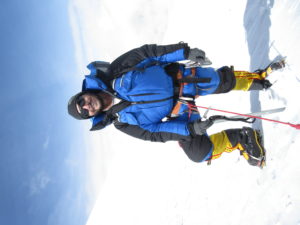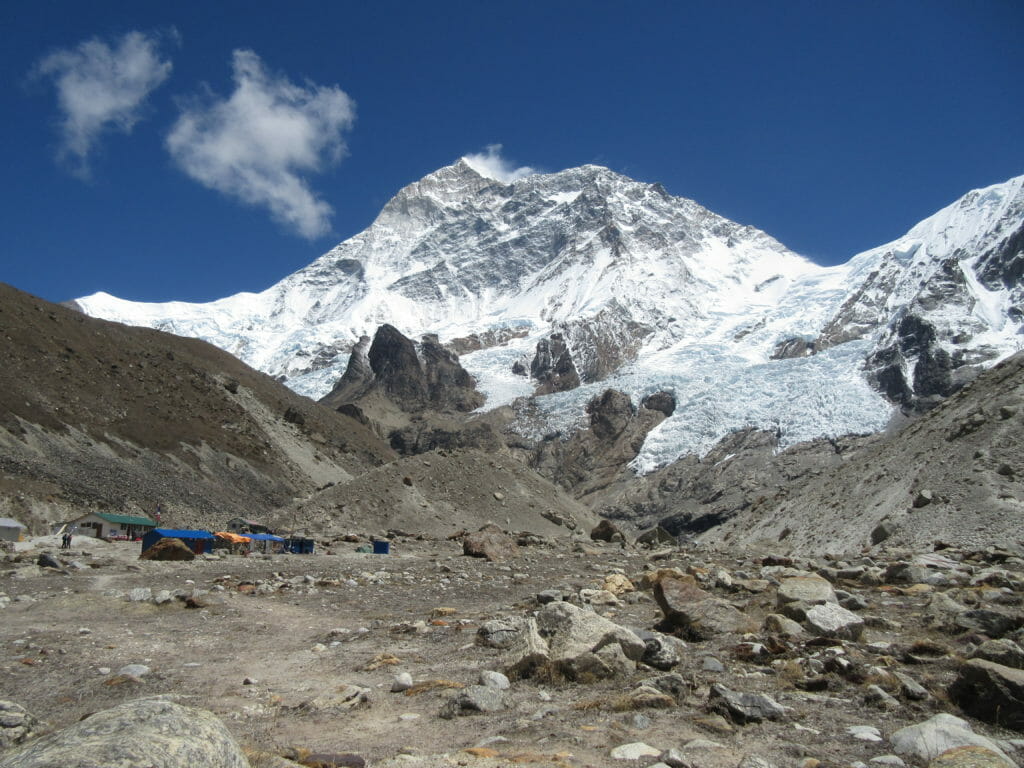Stuss Leeds is an avalanche forecaster and ski patroller living in Colorado. His lifelong dream was to climb an 8,000-meter peak.
Nearly two years ago, Colorado-based mountaineer and skier Stuss Leeds decided that he wanted to attempt a climb of Makalu (8,485 meters), the fifth-highest peak in the world. Makalu is part of Nepal’s famed northeast corner, a zone dominated by the highest terrain on earth. Located just east of Mount Everest, Makalu is an aesthetic and intimidating peak. Its south and west aspects hold sparse amounts of snow and ice, forming some of the world’s biggest high-altitude walls, and giving the peak an unmistakable pyramid-like resemblance.
Stuss says he was looking for a real challenge when he settled on Makalu. “There are easier super-high mountains. The standard route up Makalu’s north face and north ridge is not hard, but it’s way more interesting than Everest or Cho Oyu… Makalu has only a 5 percent success race. It’s in a part of Nepal I’d not been to before, and I was looking for a real adventure, something where the outcome would be uncertain.”
Without a background in training, Stuss turned to Steve and Scott’s book Training for the New Alpinism to get himself prepared for the expedition. For approximately 14 months, he made strength training, running, and CrossFit-style workouts his focus. However, with about four months left before Makalu, Stuss says, “I really wanted to amp up the training and confirm I was doing the right things.” He reached out to Steve and Scott for advice.
“I’m going to give you another gear,” Steve told Stuss over the phone.
Steve and Scott knew right away that Stuss’s training focus would have to shift if he wanted to be successful on Makalu. “They really wanted me to back off from any strength training and instead focus on Zone 1–type speed and aerobic efforts, with lots of uphill skinning.” Steve and Scott are huge advocates for this kind of training, of building a big endurance base as a pathway to success in the mountains. It’s a type of sport-specific fitness that can only be achieved through sustained, lower-intensity efforts distributed out over long periods of time.
The logistics of fitting in this type of training was not easy but Stuss says it worked and got him in specific shape of Makalu. “I’d get up at 1 a.m. in order to get a 5- or 6-hour skin in before work,” he says, which he pinpoints as being the most difficult part of the training. “The volume would increase a few weeks and then drop off. Then came added weight in a backpack. Eventually, I transitioned out of skinning and into climbing 40-degree slopes with crampons and a pack, and doing 5,000–6000 feet of vert a night. Every weekend involved one really big day—maybe 12 to 18 hours—about 50 percent of the total volume for that week.”
 Steve, who admits to having a soft spot for Makalu, kept a close watch. Stuss wore a heart rate monitor and logged his workouts. Stuss says Steve checked in on him periodically and reminded him of the importance of training his fat metabolism and mental fortitude for long days at high elevation. “So I’d have nothing in the morning—no coffee and no food—and just go,” he says. “Sometimes I’d fast for 18 hours on those huge days. It was great training for the marching on Makalu.”
Steve, who admits to having a soft spot for Makalu, kept a close watch. Stuss wore a heart rate monitor and logged his workouts. Stuss says Steve checked in on him periodically and reminded him of the importance of training his fat metabolism and mental fortitude for long days at high elevation. “So I’d have nothing in the morning—no coffee and no food—and just go,” he says. “Sometimes I’d fast for 18 hours on those huge days. It was great training for the marching on Makalu.”
Of course, dreams have a way of taking over. Despite the huge gains Stuss says he made, just one month out from his departure date, between a physical job and his training, he had pushed his body to the brink.
“I’d run myself into the ground. I was beyond exhausted. In my mind, I needed to be crescendoing. Instead, I was so exhausted and sleeping all day.”
“Overtraining,” he says. “I overdid it.” He called up Steve for another consult. Steve took one look at his training logs and confirmed Stuss’s self-diagnosed overtraining. Steve told him he absolutely had to rest. It was something Stuss wouldn’t have been able to confirm without his Steve’s knowledge and his insistence that he had to take it easy.
“I didn’t do shit for the final three weeks after 18 months [of going hard]. I was worried Makalu wouldn’t happen. Like, ‘How am I going to climb the fifth-highest mountain in the world?’ ” But when it was time to fly out, the months of training and the final induced rest period had paid off in spades. Compared with past trips, Stuss says, “I felt like this time: There was nothing more I could do.”
The approach to 8,485-meter-high Makalu starts with a nine-day trek to Base Camp through the Barun Valley. Towering above for most of this journey is Makalu’s South Face. Finally turning the corner to Base Camp, one has to pass under an even bigger wall: Makalu’s West Face. Unrelentingly steep and technical, an alpine-style ascent of this face has been Steve House’s long-term goal, one he’s attempted on three separate expeditions. Stuss says that the view gave him motivation for his own objective and made him confident that he was well prepared, knowing, “Man, my coach Steve … so astonishing that wall is his goal!”
 Arriving at Base Camp, Stuss spent day after day working his way up the mountain, carrying loads, working his way up to each camp, getting acclimatized, and weathering storms. Upon reaching Camp IV, the final high camp at around 7,800 meters, he’d spent over 30 days on Makalu. It was now time for the long and final push to the summit. On his 19-hour summit day, Stuss says that the cards fell perfectly.
Arriving at Base Camp, Stuss spent day after day working his way up the mountain, carrying loads, working his way up to each camp, getting acclimatized, and weathering storms. Upon reaching Camp IV, the final high camp at around 7,800 meters, he’d spent over 30 days on Makalu. It was now time for the long and final push to the summit. On his 19-hour summit day, Stuss says that the cards fell perfectly.
“It was a huge, clear, full moon night. The entire Himalaya was lit up below us. No headlamps needed. I knew it would happen then, even on the summit ridge.”
Stuss says that even this long summit day was not in his top-10 hardest days in the mountains, even compared to smaller peaks in the Lower 48. He accredits this to the training he did coupled with Steve’s consults: “The training works. They got me in specific shape. A couple of other climbers died on the trip. I felt good and well prepared.”
All told, Stuss spent about 40 days on Makalu. That’s a long period of time to be at high elevation and working hard. However, after just one month home, he says he feels fully recovered.
“I got home from Nepal and went running a few days later. I only regret that I contacted Scott and Steve four months before the climb. It would have been much, much better to hit them up eight months or even a year in advance to get on the ‘on ramp’ properly.”


